ASUS F2A85-V Pro Review: A Look at FM2 with A85X
by Ian Cutress on October 10, 2012 11:20 AM EST- Posted in
- Motherboards
- Asus
- Trinity
- FM2
- A85X
3D Movement Algorithm Test
The algorithms in 3DPM employ both uniform random number generation or normal distribution random number generation, and vary in various amounts of trigonometric operations, conditional statements, generation and rejection, fused operations, etc. The benchmark runs through six algorithms for a specified number of particles and steps, and calculates the speed of each algorithm, then sums them all for a final score. This is an example of a real world situation that a computational scientist may find themselves in, rather than a pure synthetic benchmark. The benchmark is also parallel between particles simulated, and we test the single thread performance as well as the multi-threaded performance.
It should be noted that this benchmark is a purely floating point benchmark, indicative of a lot of research written code where several months of optimization is not possible or not common knowledge within the research group. The compiler is not clever enough to convert what is expected into appropriate integer conversions, so Bulldozer and Piledriver based processors will only perform as well as their singular FPU units per module will allow. The benchmark is unaffected by memory speed as thread creation is created on the CPU and all data created fits well within the L2 cache per core.
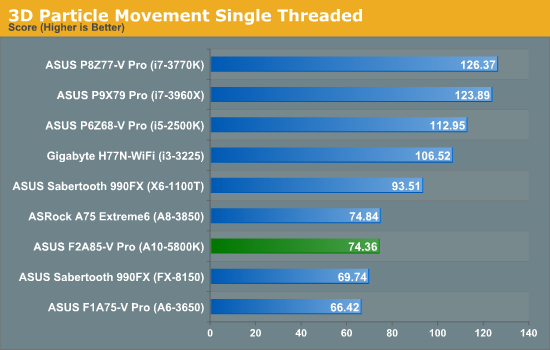
In the single threaded test, a lot of conclusions can be drawn from the comparison of AMD architectures. Direct comparison of Piledriver to Bulldozer (A10-5800K to FX-8150) gives a boost in single core performance of 7%, however comparing the old Stars cores of the A8-3850 at 2.9 GHz is roughly the same as the new Piledriver core at 4.2 GHz. So even with a 1.3 GHz advantage, Piledriver is only as good as Stars and less efficient in floating point results. If we compare Piledriver to Thuban, i.e. A10-5800K to X6 1100T, the Piledriver core gets stomped on by a good 25% performance. I find this quite staggering – most of the code I ever encountered as a computational chemist was floating point based, dealing with single and double precision on a regular basis. On this result, I would steer clear of Piledriver.

The multithreaded version of 3DPM is slightly tougher to analyze. Due to the FP nature of the program, the A10-5800K is essentially a 2 core FPU processor, whereas all the other comparative AMD processors have either 4 or 6 FPUs to play with. What is perhaps worth considering is that the Bulldozer processor with 4 modules scores 326.32, whereas the Piledriver processor with only 2 modules scores 203.06, which is more than half. This would mean that the Piledriver core actually achieves 20% better performance at the same frequency, despite our ST test giving Piledriver only a 7% increase. Part of this could be put down to the architecture improvements – improved scheduling for heavily threaded loads, one of the downfalls of Bulldozer but was improved in Piledriver could be the reason here.
WinRAR x64 3.93 - link
With 64-bit WinRAR, we compress the set of files used in the USB speed tests. WinRAR x64 3.93 attempts to use multithreading when possible, and provides as a good test for when a system has variable threaded load. If a system has multiple speeds to invoke at different loading, the switching between those speeds will determine how well the system will do. WinRAR is also very sensitive to memory speeds and subtimings.
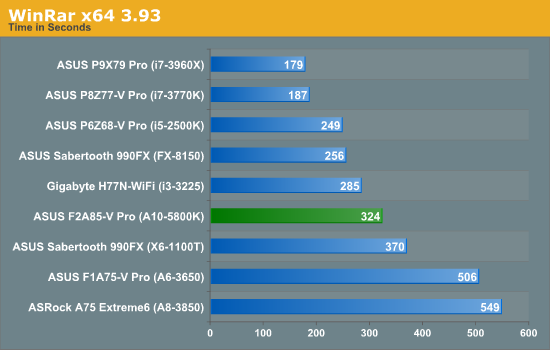
Analyzing the WinRAR results can be a little confusing, given that at different points of our previous testing the memory settings have been different (should point out that they have been consistent when comparing against like-for-like). When the A10-5800K was playing ball with DDR3-2400 10-12-12 memory, the WinRAR copy test pulled out miles ahead of the Thuban and Llano processors by a good margin. However the Sandy Bridge i5-2500K, with 4 INT and 4 FPU units gave the Trinity processor a proverbial thrashing despite being limited to DDR3-1333 at the time of testing.
FastStone Image Viewer 4.2 - link
FastStone Image Viewer is a free piece of software I have been using for quite a few years now. It allows quick viewing of flat images, as well as resizing, changing color depth, adding simple text or simple filters. It also has a bulk image conversion tool, which we use here. The software currently operates only in single-thread mode, which should change in later versions of the software. For this test, we convert a series of 170 files, of various resolutions, dimensions and types (of a total size of 163MB), all to the .gif format of 640x480 dimensions.
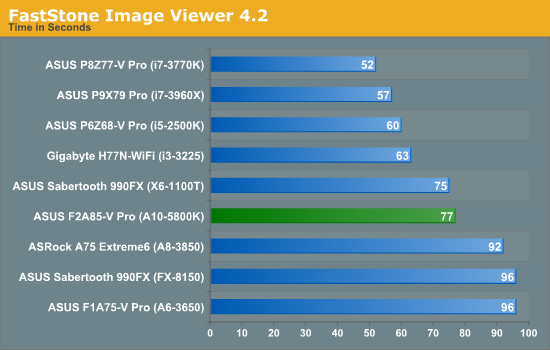
In the FastStone results, we see the Piledriver processor beat the Bulldozer and Stars cores by a considerable margin, and nudge the Thuban as well.
Xilisoft Video Converter
With XVC, users can convert any type of normal video to any compatible format for smartphones, tablets and other devices. By default, it uses all available threads on the system, and in the presence of appropriate graphics cards, can utilize CUDA for NVIDIA GPUs as well as AMD APP for AMD GPUs. For this test, we use a set of 32 HD videos, each lasting 30 seconds, and convert them from 1080p to an iPod H.264 video format using just the CPU. The time taken to convert these videos gives us our result.
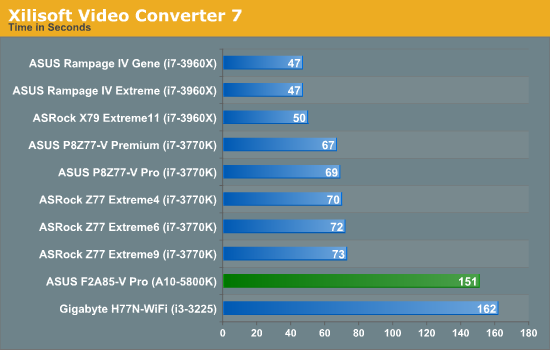
Unfortunately our Xilisoft benchmark is rather new, and thus we do not have results for all the AMD cores we have used in the past. However if we compare the A10-5800K directly with the i3-3225, we unfortunately have a memory difference to contend with (DDR3-2133 vs. DDR3-1600). With that being said, it is clear that video conversion is an INT process and all four of the A10-5800K INT units are being used.
x264 HD 4.0.1 Benchmark
The x264 HD Benchmark uses a common HD encoding tool to process an HD MPEG2 source at 1280x720 at 3963 Kbps. This test represents a standardized result which can be compared across other reviews, and is dependant on both CPU power and memory speed. The benchmark performs a 2-pass encode, and the results shown are the average of each pass performed four times.
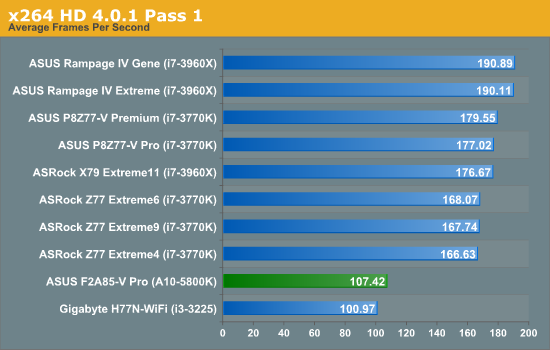
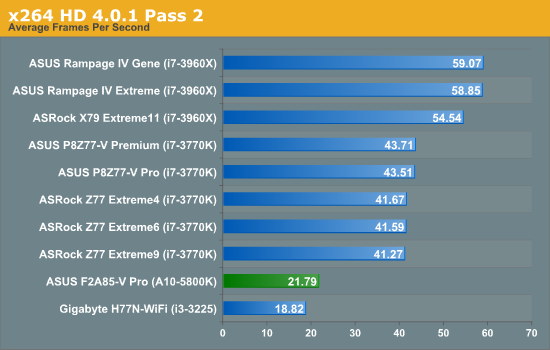










66 Comments
View All Comments
just4U - Wednesday, October 10, 2012 - link
Have you used ivy bridge or even set up any? Those puppies get quite warm and temperatures are all over the place. Hell I opted for a 2700K just because of that and prices were comparable. Using the 5800 (been working with it a few days now) it runs cool rarely going over 35C and usually staying in the low 20s in my 10 year old lian-li case (/w 3 80mm fans.. doesn't support bigger ones)CeriseCogburn - Saturday, October 13, 2012 - link
amd fanboy fails again. It's getting irritating with your idiocy and lies and pretense as if you know something. You know exactly nothing." In case of single-threaded load processors with different microarchitectures demonstrate dramatically different levels of power consumption. And here we have every right to state that Ivy Bridge microarchitecture is the most energy-efficient among all testing participants. Core i3 manufactured with 22 nm process do win the promised 8-10 W of power from their predecessors and demonstrate overwhelming advantage over the competitor’s offerings. "
No doubt that Core i3 processors from the new 3000 series will make the most energy-efficient systems. Their power consumption and therefore heat dissipation are significantly lower than by all other platforms, and their advantages over the systems with dual-core Sandy Bridge processors is between 10 and 20 W. This makes Core i3 with Ivy Bridge microarchitecture a perfect choice for compact and energy-efficient systems. And, by the way, for these particular systems Intel has special energy-efficient Core i3 CPU modifications with 35 W TDP instead of 55 W.
LOL - the amd fanboy spews his lies, and gets owned, again, after insulting the poster WHO IS CORRECT.
http://www.xbitlabs.com/articles/cpu/display/core-...
aryonoco - Wednesday, October 10, 2012 - link
At a few points in the article, Ian mentions that the chipset supports RAID5 and might therefore be a good candidate for a SOHO NAS system. My question is, does anyone who builds a SOHO NAS system actually use these integrated hardware RAIDs?Sure, nothing beats a good and proper RAID controller, but those cost upward of $300 and from experience, these integrated RAID controllers barely perform well. They are generally much slower than software RAID, and tougher to recover from failures. Nearly everyone I know who has built their own NAS goes for software RAID, and any modern OS has better software RAID than these chipsets generally provide.
The other reason not to consider Trinity for a NAS build is that power consumption is generally a major factor in a device that's 24/7 on, and Ivy Bridge beats Trinity in that regards hands down. Also, Trinity's main advantage over Ivi Bridge, that of a better GPU, is of no use in a NAS.
So, I ask again, is Trinity actually such a good choice for a NAS build? I see a place for it in a HTPC build, but pretty much in nothing else.
zappb - Wednesday, October 10, 2012 - link
Trinity has a lower idle power consumption - depending on the usage scenario, it should be cheaper to run than the ivy bridge in a NASsolarisking - Wednesday, October 10, 2012 - link
Are you guys still working on an iPhone 5 review? It's been weeks!!!Zink - Wednesday, October 10, 2012 - link
If they still don't have that done, how are they going to keep up with all of the Windows releases set to hit in 2 weeks? Flagship Windows phones and tablets probably deserve just as much attention as the iPhone and there are releases covering the whole value spectrum. I hope the iPad Mini doesn't get some 20 page review while windows tablets get the standard windows laptop type review.Snotling - Thursday, October 11, 2012 - link
There won't be an iPad mini... Unless Apple has lost its sense of direction. (which all things considered might be the case)Phiro69 - Wednesday, October 10, 2012 - link
Ian mentions a few times the motherboard - at $140 - appears overpriced for the performance & such. And yes, this Trinity sku is only somewhat comparable to an i3. But isn't the point of Trinity + FM2 to be somewhat future-insulated? As in, drop in another FM2 sku 6-12 months from now and watch your CPU & GPU performance skyrocket? Didn't AMD say FM2 is going to be around for the this gen and the next gen of processors?You might still have to be abit of an AMD fan boy to buy this combo now, but it would make a solid work PC and/or light gaming PC and a year from now, I bet $125 would drop in a huge boost in performance, without having to replace the rest of your system.
Urizane - Monday, October 15, 2012 - link
"But isn't the point of Trinity + FM2 to be somewhat future-insulated?"This depends on whether FM2 fades as quickly as FM1 and the length of time implied by 'somewhat'. Perhaps FM1 was around for 'somewhat' of a long time...maybe.
Mugur - Thursday, October 11, 2012 - link
HTPC - checked.Cheap file-server (8 x SATA 3 ports is great - I wonder whether mATX boards will have all 8) - checked.
Home Office / light gaming - checked.